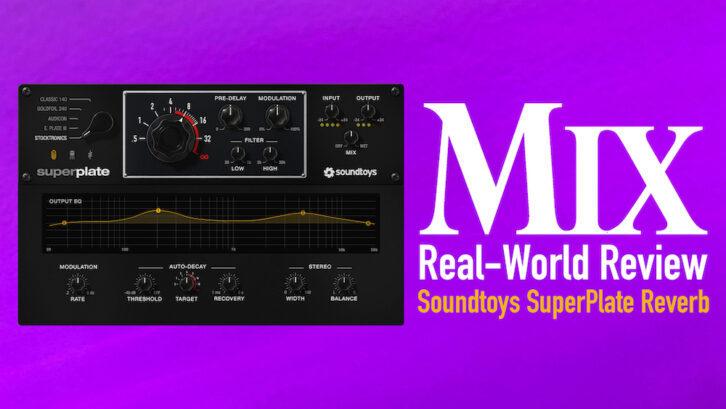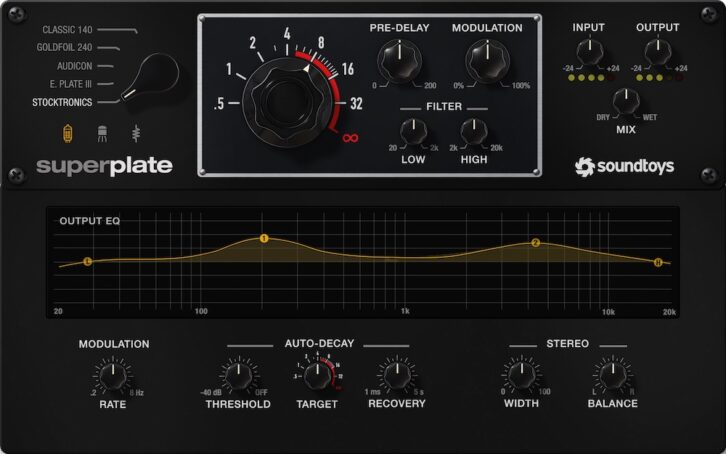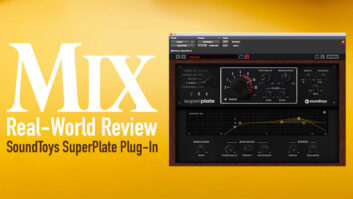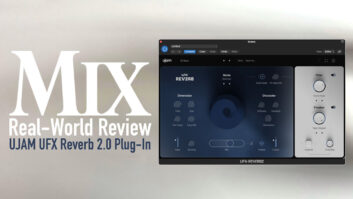
| MIX VERDICT: SOUNDTOYS SUPERPLATE REVERB |
| THE TAKEAWAY: “Great-sounding, easy-to-use, plate reverb plug-in. Highly recommended!” |
| COMPANY: Soundtoys • www.Soundtoys.com PRICE: $149 PROS: • Excellent-sounding reverb. • Auto-Decay is a winner! CONS: • No tempo sync for pre-delay. |
New York, NY (August 30, 2023)—SuperPlate is a reverberation plug-in that includes models or emulations of the five best mechanical plate reverb units ever made, and it is a huge leap over the company’s Little Plate plug-in!
Most recording engineers are familiar with the 600-plus-pound, 4 x 8-foot EMT 140 plate reverb, and also the newer and much smaller, completely different-sounding EMT 240 Goldfoil plate reverb. Less well-known are the Audicon plate; an E.Plate III preset that is a model of the ’80s EchoPlate III; and the rare Swedish Stocktronics RX4000 plate reverb—only 250 ever manufactured!
I enjoyed the process of learning the five plates in SuperPlate—characterizing their individualized sounds and deciding when, where and on what instruments and vocals they sound best in my music mixes.
Soundtoys makes it easy to switch between and compare the five reverbs; they always come up with the previous RT60 decay time, no matter which particular plate you have chosen beforehand. (RT60 is a standardized way to measure decay times in seconds at 500 Hz). RT60 is seen on the large wheel of the EMT 140 and on the remote control panel’s meter if equipped.
ADVANTAGES OF SOFTWARE MODELS
Being a software emulation, SuperPlate’s Decay time is adjustable to times way beyond the original plate’s hard limit of 5 seconds—in fact, the Decay time control goes to infinity for all five plates, for generating continuous “walls” of reverb that (naturally) darken over time. There is also the ability to “input” or add new sounds to this continuous sustaining reverb at any time.
SuperPlate is a true stereo send/return effect; when first instantiated, it’s at 100 percent Wet, with the Input and Output controls at unity gain. Being a true stereo reverb, there is the ability to “place” the reverb and source anywhere within the stereo field. I found this feature especially important when using SuperPlate as an inserted effect to localize the reverb precisely.
Brainworx bx_masterdesk Pro — A Mix Real-World Review
SuperPlate has a simplified GUI with a five-position switch to select one of the five plates, along with the usual controls for: RT60 Decay, separate Input and Output levels, a Wet/Dry Mix control for inline/insert use, Pre-Delay, Modulation Depth (0% to 100%), and Hi/Lo Filters settings, by selecting one of the three analog styles.
Clicking on the GUI’s Tweak button drops down the Tweak Menu—a larger page of controls for a 4-band graphical Output EQ, Modulation rate (Hz), Stereo Width, L/R Balance controls, and the three controls for Auto-Decay.
There are continuously adjustable Low Cut (20 Hz to 1 kHz) and High Cut (1 kHz to 20 kHz) filters with selectable slopes of 6 dB, 12 dB and 24 dB. These filters do not affect the dry source. Modulation is pitch variation of the reverb’s tail to add smoothness and reduce resonances.
Pre-Delay is adjustable from 0 to 250 ms, but strangely, in the interest of simplicity, there is no sync-to-session tempo here.

AUTO-DECAY
Auto-Decay is a unique feature that dynamically controls the length of the selected RT60 decay time based on the amplitude of the input signal. There are three controls in the Tweak Menu: Threshold, Target and Recovery.
Auto-Decay reduces the RT60 decay time depending on both the actual input level and the Threshold setting, and it solves the age-old problem of reverb buildup when using longer RT60 times. It can save time by automating reverb sends/returns, and it can sound better and more natural.
It is a fascinating effect when using a very long reverb on a lead vocal and reducing the reverb’s length whenever the vocal level approaches a preset Threshold setting. The Target control interacts heavily with Threshold to define the changing RT60 time. Recovery Time ranges from 1 ms to 500 ms and sets the time lag for the decay time to return to the Target control’s setting.
Audio-Technica ATH-M50xSTS StreamSet — A Mix Real-World Review
Auto-Decay, with its Threshold, Target and Recovery controls, requires spending time listening and learning—I’m still experimenting and building presets for my own uses. I think that Auto-Decay is an awesome effect, but warrants much more tutorial explanation in the manual.
In addition to the five plate choices, there are three choices of modeled analog input amplifiers that the plate reverbs use to drive the transducers to vibrate the metal plate inside them. Called Analog Styles, there are models of the older tube-based EMT V54 preamp, called Tube; the newer, transistorized EMT 162 with a protective limiter, called Transistor; and a third choice, Clean, that has no input amplifier coloration at all. Tube, transistor and resistor icons are used to indicate the selected style.
USING SUPERPLATE IN A MIX
I started using SuperPlate for a mix in Pro Tools and found its tonality, EQ and the nature of its reverb realistic sounding and very adjustable. SuperPlate always responded to my changes in predictable ways and reminded me why I always like a good plate reverb as compared to an actual echo chamber room.
For comparing the sound of the five reverbs, I used SuperPlate as an inserted processor rather than a send/return effect—the Wet/Dry control works precisely, and as with all Soundtoys plug-ins, you can use the company’s Parameter Lock feature to keep it from changing. On a snare drum track, the Goldfoil 240 reverb was good and not too fizzy; I managed to “redesign” a snare drum’s sound from basic and dull to a much more stylized sound that the producer loved. With the Output EQ, I boosted 800 Hz and 6 kHz using a broad EQ (holding down the Control key [Mac] broadens the Q), I kept 100% stereo width, RT60 time of 2 seconds and no Pre-Delay.
I discovered the difference between the three analog styles on this particular drum: The Tube setting is slightly darker, while the Transistor position is very slightly brighter. The Clean setting creates a completely different reverb sound altogether, with the internal reflections of the reverb better heard, which made for a longer and more complex-sounding and lovely reverb tail.
When I start a “reverb search,” I always begin by using the Clean style because it sounds more open and wide. I found that the Tube and Transistor analog amplifier models tended to compress and color the reverb’s sound. I liked it as a choice on certain instruments and vocals.
On full drum kits, the default Classic 140, with the Transistor style sounded epic! It is a bigger plate sound as compared to the EMT 240 Goldfoil. This lines up with my experiences with the original hardware units, which are getting hard to find in good working condition. I like that the Tube color is available on all the plates, even ones that never had a tube preamp, like the EMT 240. Awesome!
VOCALS
Selecting a vocal reverb provided an opportunity to try out Audicon, E.Plate III and the Stocktronics plates. I was working with a young female singer on a pop song and was looking for a quirky reverb effect that fit her music.
I chose the Audicon plate, as its punchy sound was clear and did not cloud up or “muddy” the backing track. I used SuperPlate inserted on the lead vocal track set to a 2-second Decay Time and then boosted the reverb output EQ at 4 kHz, but reduced it a little at 100 Hz. I liked this reverb to brighten up this singer’s voice, but I found the GUI’s parameter values (font size) could be a little bigger and easier to read in the drop-down Tweak menu.
For another singer, Auto-Decay worked wonderfully! I set Recovery to 1 ms—basically zero time—which can sound like gated reverb, depending on the Threshold and Target settings. There is an orange-colored collar surrounding the RT60 control that indicates the changing decay time based on the Threshold and Target settings. This is not described at all in the manual, but it is very useful for setting up Auto-Decay.
For this singer and song, here is the coolest vocal reverb chain I came up with for a quirky reverb sound. She sings phrases with long gaps in between, and, again, I placed this chain right on the lead vocal channel.
Erica Synths Zen Delay Virtual – A Mix Real-World Review
First in the chain, I used Fabrice Gabriel’s Air EQ for extensive tone carving; next was a loosely set noise gate to prevent occasional noises on the vocal track from false-triggering this effect. Next in the chain was SuperPlate using the Stocktronics plate set to a 32-second RT60 decay time! There was 40 ms of Pre-Delay, Hi/Lo filters were flat, and Modulation also not used. The Wet/Dry control was at about 50/50. Down in the Tweak Menu, the very useful Stereo Width control was set to 100%, and I automated its operation to mono for only the verses. Otherwise, the Balance control was in the center for wide stereo.
I set the Target control full counter-clockwise and Recovery time at 1 ms. The Threshold control has a red ring around it to indicate the input level. I love this feature, but again, it is a small knob with hard-to-read graphics. However, you can right-click any control and view its current value for change.
The vocal sound was unique! When she sang, the reverb was short (Target value), and after every phrase, all the gaps were now filled with a very beautiful reverb tail that lasted until the next phrase, when it stopped because of the 1ms Recovery Time that switches it back to the Target value. At the end of the chain, I set up a Sonnox Dynamics plug-in as I would any pop vocal compressor.
AWESOME AND TOTALLY DIFFERENT
I found SuperPlate to be an excellent new reverb once I learned the controls’ actions and limitations. Luckily, there are plenty of excellent presets to start from, and switching between them with the Tweak window opened will teach you a lot about this great-sounding, easy-to-use, plate reverb plug-in. Highly recommended!







